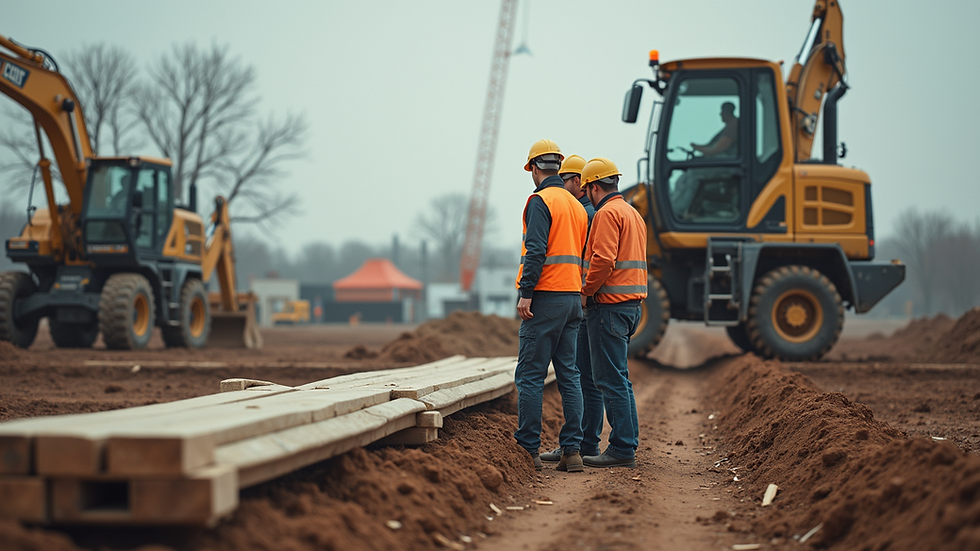Common Construction Mistakes to Avoid and How to Prevent Them
- HARSH CHAUHAN
- May 30
- 4 min read
Construction projects can be complex and challenging. Without proper attention to detail, even experienced contractors may face mistakes that could lead to significant setbacks. By understanding common construction pitfalls, you can save time, money, and frustration. This post highlights these mistakes and effective strategies for avoiding them.
Lack of Proper Planning
A major mistake in construction is failing to plan properly. Poor planning can cause confusion, cost overruns, and unexpected delays. For instance, a study by the Construction Industry Institute found that 40% of project overruns occur due to a lack of sufficient planning.
To effectively prevent this, create a well-structured plan outlining all stages of the project. Your plan should include:
Timelines for each phase of construction
Detailed budgeting for labor, materials, and potential surprises
Contingency plans to address unexpected issues
Having a defined scope of work can guide your project, ensuring it stays on track and within the budget.
Ignoring Building Codes and Regulations
Neglecting local building codes and regulations is another common mistake. Each region has specific requirements designed to guarantee safety and structural integrity. Not adhering to these codes can lead to fines, work stoppages, and dangerous safety risks.
To avoid this mistake, familiarize yourself with relevant local codes before starting your project. For example, if you are working in California, understanding California's Title 24 Building Standards is crucial for compliance. Consulting local authorities or hiring an experienced contractor can help ensure all regulatory requirements are met from the start, not only protecting you legally but also ensuring project safety and durability.
Underestimating Budget and Time Constraints
Budget overruns and missed deadlines are prevalent issues that can derail a construction project. Research shows that 65% of construction projects exceed their original budget estimates, often due to overly optimistic financial forecasting.
To prevent this, conduct comprehensive budget assessments. Factor in all applicable costs, like:
Labor
Materials
Permits
Clearly define an accurate timeline, including buffer periods for unforeseen events. Establishing open lines of communication with suppliers and subcontractors for reliable quotes can help prevent costly surprises later.
Poor Communication Among Team Members
Effective communication is critical for successful construction projects. Misunderstandings can lead to mistakes that compromise the project's quality. A survey from McKinsey found that effective collaboration can improve project performance by up to 25%.
To mitigate communication issues, establish clear channels at the project’s outset. Schedule regular meetings for updates and keep everyone aligned with project goals. Utilizing project management software can further enhance communication, ensuring all team members are informed and on the same page.

Inadequate Risk Management Strategies
Construction sites carry inherent risks, and failing to identify these can lead to accidents and potential legal issues. Reports indicate that construction site accidents account for nearly 20% of all workplace fatalities in the U.S.
To effectively manage these risks, conduct a thorough risk assessment at the project's beginning. Identify potential hazards, implement safety protocols, and ensure all workers receive adequate training. Regular safety audits will reinforce compliance with standards and reduce the likelihood of incidents.
Overlooking Site Logistics
Ignoring site logistics can lead to inefficiencies and wasted resources. Poorly organized sites can cause delays and inflate labor costs. For example, sites that lack material storage areas may lead to unnecessary searching and handling of materials, which can push labor costs up by as much as 30%.
Organize your site by planning out equipment, material, and personnel placement strategically. Designating storage areas for easy access will streamline processes. Properly managing traffic flow relies on clear organization and can significantly improve safety and efficiency for all workers.
Underestimating Weather Conditions
Weather impacts construction significantly. Ignoring potential weather disruptions can be detrimental to your project timeline and material integrity. For example, a prolonged rainstorm can delay construction by an average of 10 days, according to the National Oceanic and Atmospheric Administration.
Monitor weather forecasts closely and incorporate potential weather-related delays into your project timeline. Developing contingency plans—like having temporary shelters for materials and safety protocols for severe conditions—will help keep your project on track.
Not Customizing Designs to Meet Needs
Failing to customize designs for specific client needs or environmental conditions can lead to practical issues and dissatisfaction. Engaging clients to grasp their preferences early ensures a tailored design approach that can lead to better project outcomes.
For example, considering local climate conditions when designing a building can prevent future energy inefficiencies. Regular engagement with clients throughout the design process ensures alignment with their vision, significantly reducing the chance of dissatisfaction once the project is completed.
Final Thoughts
Avoiding common construction mistakes requires careful planning, effective communication, and a solid understanding of key project elements. Awareness of these pitfalls, along with implementing strategies to prevent them, can lead to smoother construction processes and better resource management.
From thorough budgeting and risk management to compliance with building codes and maintaining clear communication, each step is essential for delivering successful construction projects. By being proactive and attentive to these details, your construction endeavors are more likely to succeed.



![Complete Guide to Home Construction Costs in India [2025 Edition]](https://static.wixstatic.com/media/344789_cbd206aaee5a415182a059763c992f33~mv2.png/v1/fill/w_980,h_560,al_c,q_90,usm_0.66_1.00_0.01,enc_avif,quality_auto/344789_cbd206aaee5a415182a059763c992f33~mv2.png)
Comments